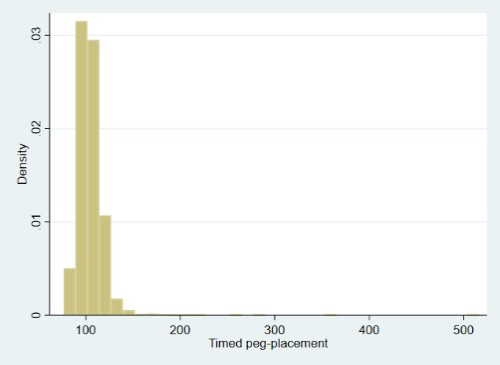The MRC National Survey of Health of Development (NSHD) assessed their cohort members (CMs) during the study’s age 43 sweep using the Motor Speed and Praxis measure.
Details on this measure and the data collected from the CMs are outlined in the table below.
| Year of data collection: | 1989 |
| Domain: | Motor skills |
| Measures: | Psychomotor speed |
| Manual dexterity | |
| Coordination | |
| Control precision | |
| Aiming | |
| CHC: | Gp (psychomotor abilities) |
| CLOSER Source: | Explore this sweep in CLOSER Discovery: NSHD 1989 (Age 43) (opens in a new tab) |
| Administration method: | Research nurse; face to face; physical task |
| Procedure: | Participants were presented with a set of pegs that were placed in holes on one side of a wooden board. They were then timed as they moved 10 the pegs from one hole to an adjacent hole on the opposite side. Five trials were conducted for each hand (10 trials total). |
| Link to questionnaire: | https://skylark.ucl.ac.uk/NSHD/lib/exe/fetch.php?media=questionnaires:1989_a_main.pdf (opens in new tab) |
| Scoring: | Mean speed across the five trials are available for each hand. A log transformed version of the mean scores are also available. |
| Item-level variable(s): | PGL189 - PGR589 |
| Total score/derived variable(s): | PEG89 |
| Descriptives: | Raw score |
| N = 3,163 | |
| Range = 77- 516 | |
| Mean = 104.49 | |
| SD = 15.62 | |
(click image to enlarge) |
|
| Age of participants (months): | Mean = 521.84, SD = 2.19, Range = 514 - 533 |
| Other sweep and/or cohort: | None |
| Source: | This task was developed specifically for this study. Similar manual dexterity tasks have been used as screeners for manual dexterity difficulties since the 1940s, e.g. Tiffin and Asher (1948). |
| Technical resources: | None |
| Example articles: | Richards, M., Hardy, R., & Wadsworth, M. E. (2004). Alcohol consumption and midlife cognitive change in the British 1946 birth cohort study. Alcohol and Alcoholism, 40(2), 112-117. |
| Richards, M., & Wadsworth, M. E. J. (2004). Long term effects of early adversity on cognitive function. Archives of Disease in Childhood, 89(10), 922-927. |
Go to:
- Overview of all cognitive measures in NSHD
- Overview of adulthood cognitive measures across all studies
This page is part of CLOSER’s ‘A guide to the cognitive measures in five British birth cohort studies’.
